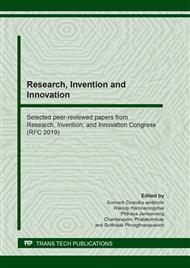p.169
p.175
p.182
p.190
p.198
p.205
p.211
p.218
p.224
Synthesis of Biogenic Nanosilica from Rice Husk: Using Scaling-Up Batch Reactor from Laboratory
Abstract:
Biogenatic nanosilica was synthesized by sol-gel method from rice husk ash. The batch reactor was designed to scaling-up from laboratory scale approximately 5 g to approximately 300 g of the feed raw materials. The synthesized silica products from lab-scale vessel and scaling up designed batch reactor were compared with percent yield and nanoparticle size. The particles of nanosilica from both scale productions were characterized by X-ray Fluorescence (XRF), X-ray Diffraction (XRD) and Scanning Electron Microscope (SEM). The size and size distribution of nanoparticles were estimated by ImageJ software in 100 points from SEM images. The synthesized nanosilica particles from laboratory vessel and designed reactor were the same of % yield production, components, physical structure, silica purity, and nanoparticle size. Moreover, the commercial nanosilica was analyzed for comparison.
Info:
Periodical:
Pages:
198-204
Citation:
Online since:
August 2020
Authors:
Keywords:
Price:
Сopyright:
© 2020 Trans Tech Publications Ltd. All Rights Reserved
Share:
Citation:


